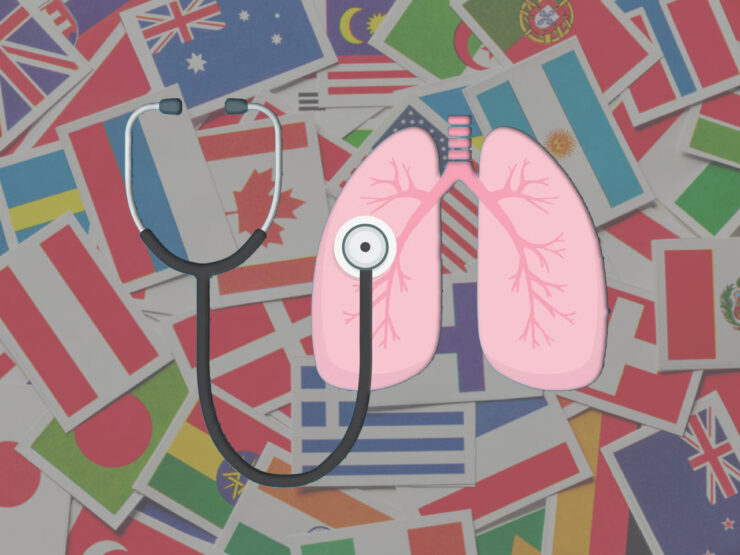Lung cancer, a leading cause of cancer-related deaths worldwide, has varying prevalence rates across different countries. The rates of lung cancer can be influenced by numerous factors, including smoking habits, environmental pollutants, and genetic predispositions.
Here, we delve into the top ten countries with the highest lung cancer rates per 100,000 people.
1️⃣ Hungary 🇭🇺

- Rate: 50.1 per 100,000 people
- Additional Information: Hungary has the highest lung cancer rate globally, which can be attributed to its high smoking prevalence and exposure to environmental carcinogens. The country has been implementing anti-smoking campaigns and regulations to curb this alarming rate.
2️⃣ Serbia 🇷🇸

- Rate: 47.3 per 100,000 people
- Additional Information: Serbia’s high rate is closely linked to its tobacco consumption and lack of stringent anti-smoking laws. Efforts are being made to raise awareness and reduce smoking habits.
3️⃣ France 🇫🇷

- Rate: 42.9 per 100,000 people
- Additional Information: France, known for its rich history and culture, also has a significant number of smokers. The government has initiated several programs to reduce smoking and promote healthier lifestyles.
4️⃣ French Polynesia 🇵🇫
- Rate: 40.4 per 100,000 people
- Additional Information: The high rate in French Polynesia may be influenced by genetic factors and lifestyle habits. Research is ongoing to understand the specific causes.
5️⃣ Turkey 🇹🇷

- Rate: 40.0 per 100,000 people
- Additional Information: Turkey’s lung cancer rate is impacted by its widespread tobacco use. The government has been proactive in implementing smoking bans in public places.
6️⃣ Montenegro 🇲🇪
- Rate: 39.7 per 100,000 people
- Additional Information: Montenegro faces challenges in controlling tobacco use, which significantly influences its lung cancer rate.
7️⃣ Belgium 🇧🇪
- Rate: 38.3 per 100,000 people
- Additional Information: Belgium’s rate can be linked to its industrial history and the associated pollutants, in addition to smoking habits.
8️⃣ Bosnia 🇧🇦
- Rate: 37.8 per 100,000 people
- Additional Information: Bosnia’s rate is influenced by a combination of smoking habits and exposure to environmental carcinogens.
9️⃣ North Korea 🇰🇵
- Rate: 37.0 per 100,000 people
- Additional Information: Limited data is available on North Korea, but it’s speculated that smoking habits and other factors contribute to its rate.
🔟 Denmark 🇩🇰
- Rate: 36.8 per 100,000 people
- Additional Information: Denmark’s rate is influenced by its smoking habits and the presence of certain environmental pollutants.
Rank Women:
| Rank (women) | Country | Number | ASR/100,000 |
| World | 770,828 | 14.6 | |
| 1 | Hungary | 4,462 | 38.1 |
| 2 | Denmark | 2,648 | 36.8 |
| 3 | The Netherlands | 6,450 | 33.5 |
| 4 | Ireland | 1,628 | 32.9 |
| 5 | US | 111,540 | 30.4 |
| 6 | UK | 25,040 | 29.9 |
| 7 | Serbia | 2,639 | 29.8 |
| 8 | Iceland | 107 | 29.6 |
| 9 | North Korea | 6,470 | 28.7 |
| 10 | Brunei | 56 | 28.0 |
Rank Men:
| Rank (men) | Country | Number | ASR/100,000 |
| World | 1,435,943 | 31.5 | |
| 1 | Turkey | 34,207 | 74.8 |
| 2 | Serbia | 5,409 | 68.0 |
| 3 | Hungary | 5,812 | 66.6 |
| 4 | Bosnia and Herzegovina | 1,984 | 64.7 |
| 5 | Montenegro | 318 | 61.2 |
| 6 | France, New Caledonia | 110 | 59.9 |
| 7 | Armenia | 1,101 | 56.8 |
| 8 | Greece | 6,786 | 56.3 |
| 9 | French Polynesia | 100 | 55.3 |
| 10 | Slovakia | 2,531 | 54.3 |
Frequently Asked Questions (FAQ)
- Why do some countries have higher lung cancer rates than others?
- Different countries have varying factors influencing their rates, including smoking habits, environmental pollutants, and genetic predispositions.
- How can lung cancer rates be reduced?
- Implementing strict anti-smoking campaigns, raising awareness about the dangers of tobacco, and promoting regular health check-ups can help reduce lung cancer rates.
- Are there any preventive measures for lung cancer?
- Avoiding tobacco, reducing exposure to environmental carcinogens, and maintaining a healthy lifestyle can act as preventive measures.
- How reliable are these statistics?
- The statistics are based on global health databases and research. However, it’s essential to note that data can vary based on sources and the methodology used in studies.
- Can lung cancer be cured?
- Early detection and treatment can lead to better outcomes. However, the prognosis varies based on the stage of cancer and other factors.
Reference:
- World Cancer Research Fund International
- Title: Lung cancer statistics
- Abstract: This source provides comprehensive statistics on lung cancer, detailing its prevalence worldwide. It also offers age-standardized rates and breaks down the data by gender.
- PMC – National Center for Biotechnology Information
- Title: Global Epidemiology of Lung Cancer
- Abstract: This article discusses the trends in smoking rates and their correlation with lung cancer incidence and mortality. It highlights the differences between industrialized countries and the developing world.
- The Cancer Atlas
- Title: Lung Cancer
- Abstract: This source provides a detailed overview of the causes of lung cancer deaths, the global burden of the disease, and various risk factors. It references multiple studies and offers insights into the global trends of lung cancer.
- US Department of Health and Human Services
- Title: The Health Consequences of Smoking—50 Years of Progress: A Report of the Surgeon General
- Abstract: This report from the US Department of Health and Human Services provides an in-depth analysis of the health consequences of smoking over the past 50 years.
- International Agency for Research on Cancer
- Title: Global Cancer Observatory: Cancer Today
- Abstract: This source offers a comprehensive database on global cancer statistics, including lung cancer. It provides data on incidence, mortality, and prevalence rates.















